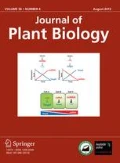Literature cited
Baba J, Yokota T, Takahashi N (1983) Brassinolide-related new bio-active steroids fromDolichos lablab seed. Agric Biol Chem47: 659–661
Clouse SD, Langford M, McMorris TC (1996) A brassinosteroid-insensitive mutant inArabidopsis thaliana exhibits multiple defects in growth and development. Plant Physiol111: 671–678
Clouse SD, Sasse JM (1998) Brassinosteroids: Essential regulators of plant growth and development. Annu Rev Plant Physiol Plant Mol Biol49: 427–451
Fujioka S (1999) Natural occurrence of brassinosteroids in the plant kingdom,In A Sakurai, T Yokota, SD Clouse, eds, Brassinosteroids: Steroidal Plant Hormones. Springer-Verlag, Tokyo, pp 21–45
Ikekawa N, Takatsuto S, Morisaki M (1984) Analysis of natural brassinosteroids by gas chromatography and gas chromatography-mass spectrometry. J Chromatogr290: 289–302
Kim SK (1991) Brassinosteroids: Natural occurrences of brassinosteroids,In T Yokota, G Adam, eds, Chemistry, Bioactivity and Application, ACS Symposium Series 474, American Chemical Society, Washington DC, pp 26–35
Kim SK, Yokota T, Takahashi N (1987) 25-Methyldolichosterone, a new brassinosteroid with a tertiary butyl group from immature seed ofPhaseolus vulgaris. Agric Biol Chem51: 2303–2305
Li J, Chory J (1997) A putative leucine-rich repeat receptor kinase involved in brassinosteroid signal transduction. Cell90: 929–938
Oh MH, Clouse SD (2003) Brassinosteroids: Modes of BR action and signal transduction. J Plant Biol46: 1–9
Park SC, Kim TW, Kim SK (2000) Identification of brassinosteroids with 24R-methyl in immature seeds ofPhaseolus vulgaris. Bull Kor Chem Soc21: 1274–1276
Silverstein RM, Webster FX (1998) Spectrometric Identification of Organic Compounds. Ed 6, John Wiley and Sons, New York, pp 144
Takatsuto S, Ying B, Morisaki M (1982) Microanalysis of brassinolide and its analogues by gas chromatography and gas chromatography-mass spectrometry. J Chromatogr239: 233–241
Yokota T (1997) The structure, biosynthesis and function of brassi-nosteroids. Trends Plant Sci2: 137–143
Yokota T, Higuchi K, Takahashi N, Kamura Y, Watanabe T, Takatsuto S (1998) Identification of brassinosteroids with epimerized substituents and/or the 23-oxo group in pollen and anthers of Japanese cedar. Biosci Biotechnol Biochem62: 526–531
Yokota T, Koba S, Kim SK (1987) Diverse structural variations of the brassinosteroids inPhaseolus vulgaris seed. Agric Biol Chem51: 1625–1631
Author information
Authors and Affiliations
Corresponding author
Rights and permissions
About this article
Cite this article
Hwang, J.Y., Park, C.H., Namgung, H. et al. Identification of a new brassinosteroid, 23-dehydro-2-epicastasterone, from immature seeds ofPhaseolus vulgaris . J. Plant Biol. 49, 409–412 (2006). https://doi.org/10.1007/BF03178820
Received:
Accepted:
Issue Date:
DOI: https://doi.org/10.1007/BF03178820

